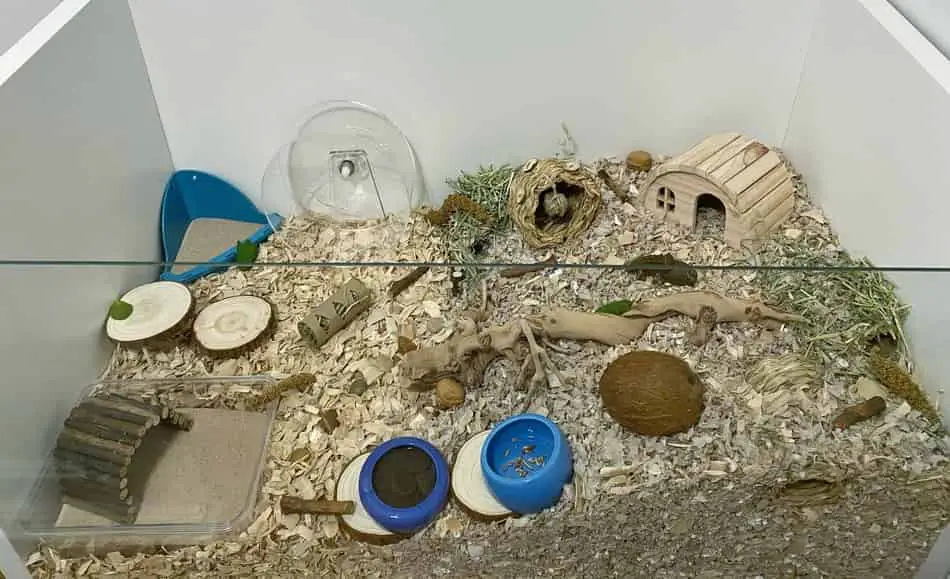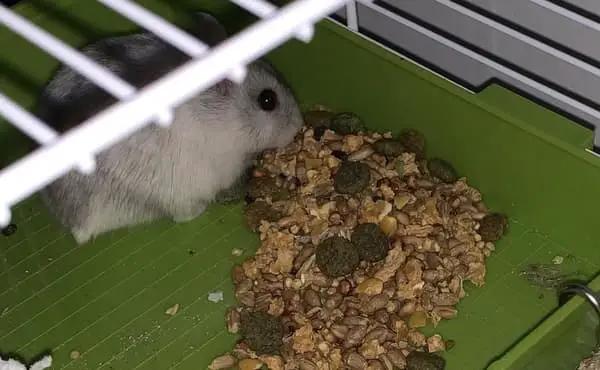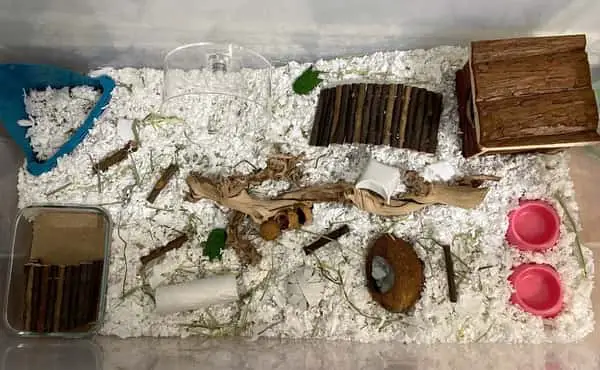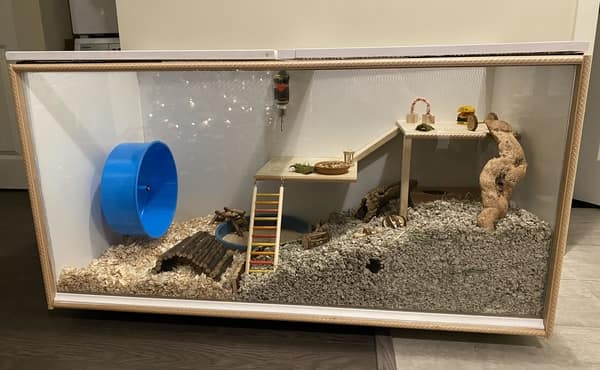There are quite a few things many hamster owners are not prepared for when they bring their pals home, like how much personality is packed into those tiny little bodies, or the fact that hamsters are just as prone to colds as we are. However, a more uncommon situation that occurs more frequently than one might expect is finding ants in your hamster’s cage.
So, why does my hamster cage have ants? The most likely answer is that the ants are attracted to food in your hamster’s enclosure, although there are a few other possibilities.
This article will examine how the type and/or amount of food in your hamster’s enclosure likely is attracting ants. We will also explore cleanliness and location of the enclosure as possible causes, and we will discuss some ways to repel these pests from your pocket-sized pal for good.
What’s Cookin’?
Hamsters have rich and diverse diets given that they are omnivorous, meaning they eat both plant- and animal-based materials. Wild hamsters subsist on grasses, seeds, grains, insects, and even small lizards and amphibians!
Their housebound cousins’ diets should be just as diverse, with hamster “mix,” fresh vegetables and fruit, and occasional protein-packed treats like meal worms or boiled eggs. With such a large array of delicious morsels lying around, it makes sense that in certain regions or during certain times of year, the most infamous treat-seeking pest might make an appearance: the ant.
If you are seeing ants in or around your hamster’s enclosure, it most likely is due to your pal’s food. Fortunately, you are not alone and there are plenty of things you can do to repel these pests. Unfortunately, it might be difficult at first to narrow down exactly what is drawing the ants in to begin with.
For starters, the fresh bowl of food you gave your pal ten minutes ago may not be what the ants are after—hamsters are hoarders! This means that any time you top off your furry friend’s food dish, or give them a particularly tasty treat, they might take it somewhere else to stash it and eat later instead of eating it then and there.
Wild hamsters tend to inhabit harsh climates like arid deserts or rocky steppes, where the abundance of food can vary wildly. This compelled hamsters to evolve into hoarders who forage for food every night to stuff into their big cheeks and hide in their burrows for a rainy day.
Our domestic pals have that same instinct, despite the fact that they never need to worry about food scarcity.
Chances are your pocket-sized pal has at least one food stash that it likes to attend to when it gets a case of the munchies. If these mini doomsday food stores are not cleaned out regularly, the food can spoil and attract ants. Clean out your hamster’s stash every couple of days to be safe.
Furthermore, look to the types of food that you are feeding—is the mix you give your pal a “muesli style” mix with added honey or sugar? If so, this may be what is drawing in your unwanted guests.
Beyond sweet treats, the fresh foods you give your hamster may also be the culprits. Anytime you feed fresh vegetables or fruits, give them separately and remove them once your pal is finished eating. If they sit in the cage for an extended period, chances are the ants will find it.
Finally, as cringeworthy as it might be to think about, there may be eggs in the food you bring home for your hamster from the pet store.
This is not necessarily bad for your ham if the eggs do not hatch, although it is not ideal, but that could be the source of your problem. If you suspect this is the case, you can either store your food in tightly sealed containers in the fridge to prevent eggs from hatching or start from scratch with a new batch.
If you do not think food is the problem, perhaps the cleanliness of your pet’s enclosure is attracting your six-legged guests.
Good Housekeeping
Hamsters are notorious for being messy housemates, so do not be dismayed if your pet’s habitat is not always pristine. This messiness can quickly become malodorous, however, especially if you have more than one hamster. The odors produced by your pal’s messy lifestyle could be what is drawing ants to your home within a home.
Although messiness is normal, hamsters do need help tidying up to prevent messes from getting too out of control, which is where we humans come in! Your pet’s enclosure should be cleaned in its entirety about once a month, meaning remove all bedding, food stores, dishes, and toys, and sanitize the entire habitat with warm, soapy water or a special cleaning spray.
Once a week (more if you have more than one ham in a single enclosure) replace all the bedding and food stores in the enclosure. “Spot clean,” or scoop out soiled bedding or messes, every day or two to keep the enclosure from becoming too pungent between cleanings.
Finally, clean food dishes and water bottles daily to reduce the chance of contamination and prevent ants from gathering. The longer food or odorous messes sit unattended, the higher the chances are of your local colony locating it and throwing a party.
As with your pal’s food, there is a small chance that ant eggs could be stowing away in the bedding you purchased for the enclosure. Store newly purchased bedding in the freezer, or scrap it and get a new package, if you think this may be the case.
Further, use a soft-bristled toothbrush or small animal comb to check your furry friend’s luxurious coat—ants may be hiding in there as well, perhaps brought inside after some garden time. Finally, vacuum or mop the area surrounding your pet’s enclosure regularly for even more thorough cleanliness.
If you already maintain good housekeeping habits for your hamster’s habitat but still have ants, look at where the enclosure is located for clues as to the source of the issue.
Location, Location, Location
When it comes to a hamster’s habitat, often like our human ones, location is everything! A hamster’s enclosure should be kept in a clean, dry, temperate area away from household appliances like dishwashers, washing machines, or even running water (they produce ultrasound to which hams are quite sensitive) for overall well being.
Additionally, they should be housed away from windows with direct sunlight, as they are nocturnal. Luckily for us, many of these common practices regarding healthy hamster housing are also things that can prevent ants from invading our pals’ space.
If you are having an ant problem, observe the location of your hamster’s enclosure. Is it close to a window or door that leads outside? Is it in or near the kitchen or a bathroom?
Perhaps there are points in your home with less-than-solid structural integrity through which unwanted guests can come through? (Do not worry—you are not alone there!) If you answered yes to any of these questions, try moving your furry friend’s digs to a new location.
Further, what is the temperature like in your pal’s living quarters? The ideal temperature for a hamster habitat is between 65- and 75-degrees Fahrenheit, which is lucky for us since warmer temperatures draw in pests.
If your room is warmer than 75 degrees, adjust your thermostat as soon as possible! Pests love warmth, but they also love humidity—again, ideal conditions for your hamster are already in line with conditions that should help prevent pest invasion, so make sure the area is dry.
If you live in a humid climate, consider investing in a humidifier for the comfort and safety of both your pet and you!
Regardless of how your unwanted guests arrived, it likely is safe to assume you want them gone—fortunately, there are several ways you can get rid of them and prevent future invasions that are safe for you and your pal.
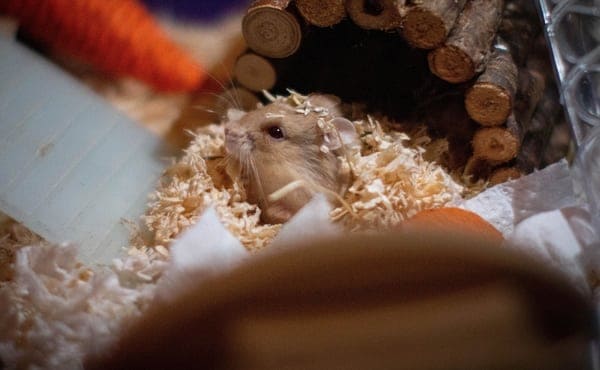
How to Get Rid of Ants in Hamster Cage
The first thing to do to get rid of pests while preventing future visits is find the source. Carefully examine all the areas surrounding your pet’s enclosure, including windows, doors, floorboards, cracks, etc., to determine their point of entry.
Bear in mind they could be coming in from another room, such as the kitchen or bathroom, so check there as well. Once you have determined where they are breaking and entering from, you can decide what method you will use to banish them.
A common method to rid a home of ants is baited traps. These are typically small, plastic traps containing liquid or granular ant poison that ants take back to their colonies, leaving your home free of both ants, alive or dead, and wide-spread chemicals, making them an easy and safe option. Further, there are numerous natural pest repellent methods such as the ones listed below:
Peppermint Oil—place a couple drops on a cotton ball and swipe suspected areas of entry (be careful with essential oils around your ham though!)
Vinegar—use a 1:1 ratio with water and spray vinegar directly on ants to kill them and around areas of entry to prevent future invasions
Lemon Juice—use 1:3 ratio with water and spray around suspected areas of entry and areas you have seen ants “marching,” as this acidic solution will destroy their scent trails
Cinnamon—sprinkle dry cinnamon around your ham’s enclosure and anywhere you have seen ants
Cayenne or Black Pepper—sprinkle pepper at suspected areas of entry to repel pests
Diatomaceous Earth—use food-grade diatomaceous earth to sprinkle around the perimeter of your home to prevent future visits
This list is not all-inclusive, there are plenty of other “remedies” to prevent unwanted visits from tiny houseguests, but it is a great place to start. In any case, always try using these methods before resorting to spraying poison, as it could end up harming your pet too.
Furthermore, if your ham happens to run into any dead ants, they may try to eat them and end up ingesting poison, so natural or low-impact methods such as ant baits or those listed above are always a safer choice.
Conclusion
If you have noticed ants congregating around your hamster’s digs like they are about to throw a party, chances are it is because of your pal’s food. Make sure food stashes and dishes are cleaned out regularly.
Speaking of cleaning, your companion’s messy lifestyle may also be drawing in your unwanted guests, so spot clean messes daily and clear out bedding once a week. Additionally, the location of your pet’s enclosure could be at the bottom of the ant invasion. Make sure you house your companion away from windows and doors and refrain from placing them in bathrooms or kitchens.
Finally, once you have figured out the reason for and source of your unwanted guests, you can repel them using any one of several methods for the health and safety of both you and your furry friend.
Do not feel bad if you find these pesky visitors in your pet’s enclosure, it is more common than you may think and is easily solved and prevented again in the future, so you and your pocket-sized pal can worry about the important stuff like treats and snuggles.

